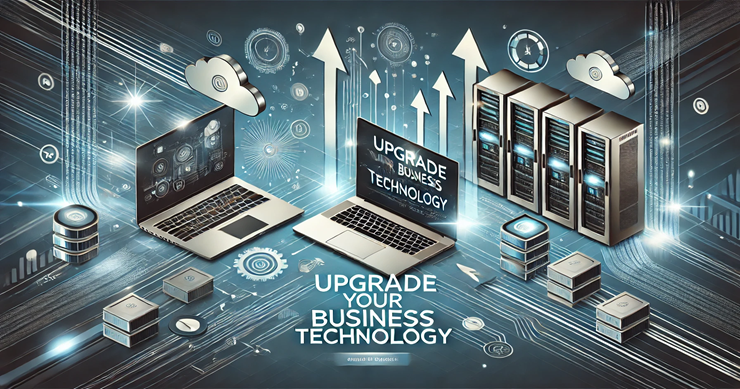Recognizing the Right Time to Invest in Modern Systems for Growth and Success
Introduction
In today’s fast-paced digital era, technology drives business growth, efficiency, and competitiveness. However, outdated technology can hinder productivity, expose businesses to security vulnerabilities, and escalate costs. Understanding when to upgrade your business technology is vital for staying ahead in your industry. This article explores the top five signs indicating that it’s time for a technology refresh, providing insights and actionable advice for business owners.
History and Background
The Evolution of Business Technology
Technology has evolved dramatically over the last few decades, from the introduction of personal computers in the 1980s to the widespread adoption of cloud computing, artificial intelligence, and big data in the 21st century. Each technological wave has brought new tools and systems that have reshaped industries.
Why Businesses Must Keep Up
Businesses historically resistant to technological change have faced challenges in adapting to market demands. For example, Kodak’s failure to transition to digital photography serves as a cautionary tale. Modern businesses must remain agile, leveraging new tools to meet customer expectations, streamline operations, and ensure cybersecurity.
Core Concepts/Principles
1. Recognizing the Need for Performance Optimization
Aging technology often struggles to keep up with growing demands. Sluggish systems and frequent downtime can disrupt workflows and erode customer trust. Upgrading ensures smoother operations and faster response times.
2. Adapting to Industry Changes
Business environments evolve rapidly, necessitating adaptable systems. New applications and platforms often require updated hardware and software for seamless integration.
3. Balancing Cost and Value
While older systems may seem cost-effective initially, their increasing maintenance and repair costs often outweigh the benefits. Upgrading to newer systems minimizes long-term expenses.
4. Prioritizing Cybersecurity
Hackers target vulnerabilities in outdated systems. Regular upgrades ensure access to the latest security patches and features, protecting sensitive data and customer trust.
5. Preparing for Scalability
As businesses grow, so do their technological needs. Scalable systems accommodate increased demand without compromising performance, enabling sustainable expansion.
Current Trends and Developments
Trend 1: Cloud Computing Adoption
The shift to cloud-based solutions allows businesses to access flexible, scalable, and cost-effective infrastructure. According to Gartner, global spending on cloud services is expected to exceed $600 billion by 2024.
Trend 2: AI and Automation Integration
Artificial intelligence (AI) and automation are transforming industries by optimizing processes, enhancing customer experiences, and reducing costs.
Trend 3: Enhanced Cybersecurity Measures
Cybersecurity technologies such as multi-factor authentication, zero-trust architecture, and AI-based threat detection are becoming standard in modern business environments.
Trend 4: Sustainability in Tech
Eco-friendly technologies, such as energy-efficient servers and green computing practices, are gaining traction as businesses aim to reduce their carbon footprint.
Applications and Implications
1. Productivity Boost
Upgraded technology enhances employee productivity by providing faster, more reliable tools for day-to-day tasks.
2. Improved Customer Experience
Modern systems support better customer relationship management, faster response times, and seamless digital interactions.
3. Competitive Advantage
Staying current with technology enables businesses to outperform competitors by leveraging innovative solutions and data-driven insights.
4. Cost Savings
While the initial investment in new technology may seem high, it reduces long-term maintenance costs and minimizes downtime.
Challenges and Solutions
Challenge 1: High Upfront Costs
Solution: Consider financing options, leasing programs, or phased upgrades to spread out costs over time.
Challenge 2: Employee Resistance
Solution: Offer training programs and communicate the benefits of new systems to encourage buy-in from staff.
Challenge 3: Disruption During Transition
Solution: Partner with IT professionals to ensure a smooth migration process with minimal impact on operations.
Challenge 4: Compatibility Issues
Solution: Conduct a thorough assessment of existing systems and choose technology that integrates seamlessly with current infrastructure.
Future Prospects
Emerging Technologies
- Quantum Computing: Promises unparalleled computational power, revolutionizing industries such as finance, healthcare, and logistics.
- IoT (Internet of Things): Increasing connectivity between devices offers real-time data and smarter decision-making.
- Blockchain: Enhances security and transparency in transactions, especially in industries like finance and supply chain.
Automation and AI Expansion
AI-driven technologies will continue to advance, streamlining processes and improving decision-making capabilities.
Sustainability Initiatives
Eco-friendly innovations in tech will drive future upgrades, aligning with global sustainability goals.
Case Studies/Examples
Case Study 1: A Retailer’s Digital Transformation
A mid-sized retail chain upgraded its outdated point-of-sale (POS) system to a cloud-based solution, resulting in faster transactions and better inventory management. The transition improved customer satisfaction and boosted sales by 15%.
Case Study 2: Small Business Cybersecurity Overhaul
A small accounting firm faced a ransomware attack due to outdated security software. After upgrading to modern security tools, including endpoint protection and regular backups, the firm avoided further attacks and regained client trust.
Conclusion
Upgrading your business technology is no longer optional—it’s a necessity for growth, efficiency, and security. Recognizing the signs of outdated systems and taking proactive steps to upgrade ensures that your business stays competitive in today’s technology-driven world.
To get started, assess your current systems, consult IT experts, and develop a roadmap for modernization. At PC Runs, we’re here to help you navigate the process and implement tailored solutions for your business needs.
Call to Action: Explore our services, subscribe to our newsletter for the latest tech updates, or contact us for a consultation. Don’t let outdated technology hold you back—upgrade today for a brighter tomorrow!





